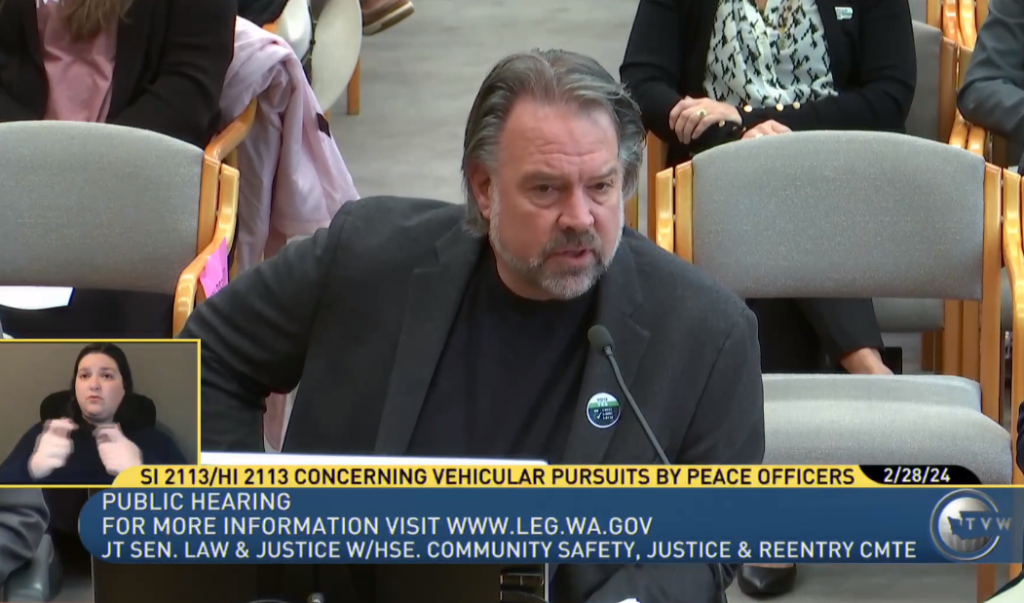SNOHOMISH COUNTY—Last Thursday the Snohomish County Sheriff’s Office added policy 307 to its Law Enforcement Policy Manual which details the agency’s approach to how it will conduct a vehicular pursuit moving forward.
In that policy, specifically section 307.3.1, Deputies are authorized to initiate a vehicular pursuit when it is “reasonable to believe” that a suspect, who has been given an appropriate signal (emergency lights and siren) to stop by a law enforcement officer, is attempting to evade arrest or detention by fleeing in a vehicle and there is reasonable suspicion to believe that a person in the vehicle has committed or is committing a felony, poses a threat to the safety of others, and a supervisor has been notified and maintains supervisory control.

On the other end a police pursuit is not authorized, under policy 307, solely under traffic infractions, administrative violations (such as driving with a suspended license), warrants (regardless of crime), misdemeanors and gross misdemeanors, and probably cause for eluding.
Additionally, the policy states that alternatives to police pursuits should be considered by a deputy and a supervisor.
When forming their decision to authorize a pursuit, a supervisor must consider the following: speed, weather, traffic, road conditions, and the known presence of minors in the vehicle. The vehicular pursuit must be terminated if any of the requirements of this policy are not met, the policy states.
PIT maneuvers are permitted without supervisor approval if below speeds of 50 miles per hour.
The policy further frowns upon the use of firearms, unless meeting the requirements of its strict use of force guidelines, roadblocks, unless supervisor-approved, tire deflation, also unless supervisor approved, or the ramming of a vehicle unless it appears there are no other alternative measures.
Police officers conducting a pursuit are required to practice specific driving tactics mapped out by the office’s new policy including not pursuing a vehicle that is driving the wrong way on a roadway, highway, or freeway, have an available deputy block off intersections and available exits ahead of the pursuit to avoid collisions, and contact the Washington State Patrol or other agencies of the pursuit transfer to another jurisdiction.
The Sheriff’s Office’s new policy also requires mandatory training for all law enforcement officers on police pursuits and requires an annual report be generated by the Office of Professional Accountability (OPA) which includes a statistic analysis of all conducted/terminated police pursuits, any and all new law changes regarding pursuits, and any and all trends regarding police pursuits.
A pursuit should be terminated if the suspect’s vehicle’s location is no longer known, the pursuing vehicle suffers mechanical damage or its lights become inoperable, there becomes an immediate hazard to the public, the distance between the pursuer and suspect is so large the pursuit becomes futile, or the danger of the pursuit outweighs allowing the suspect to be at large.
Police pursuits have been a contentious topic for police departments across the nation since the murder of George Floyd at the hands of Minnesota police officer Derek Chauvin in 2020 that sparked controversies surrounding an officer’s right to use excessive force during arrests. The incident also prompted several law makers to re-codify laws when and how a law enforcement officer may conduct pursuits.
In 2021, the Washington State legislature passed engrossed substitute House Bill 1054, sponsored by Representative Jesse Johnson (D-Federal Way), which in part codified statewide vehicular pursuit regulations.
The law prohibited vehicular pursuits unless the pursuing officer had probable cause to believe that a person in the vehicle has committed or is committing a violent offense, a sex offense, or an escape offense, or if the officer has reasonable suspicion the operator of the vehicle is committing a DUI offense. The pursuit must also be necessary to identify or apprehend the person and the fleeing person must have posed an imminent threat to the safety of others and the safety risks of failing to apprehend or identify the fleeing person must have been considered greater than the safety risks associated with the pursuit.
The law also required supervisory control of the pursuit but made certain exceptions to this requirement for jurisdictions with fewer than 10 commissioned officers.
In 2023, the legislature passed engrossed substitute Senate Bill 5352, sponsored by Senator John Lovick (D-Mill Creek), that modified the regulations on vehicular pursuits. Under this new law, the evidentiary threshold to engage in a pursuit was lowered from probable cause to reasonable suspicion that the person in the vehicle has committed or is committing one of the enumerated offenses. Also, the crimes of vehicular assault and domestic violence assaults were added to the list of crimes for which an officer may initiate a pursuit.
Rather than receive authorization to initiate a pursuit, under the new law, officers were required to notify their supervisor, who then maintains oversight of the pursuit. However, exceptions were made for jurisdictions with fewer than 15, rather than 10, commissioned officers. Requirements, under the new law, also specified that officers must coordinate with other jurisdictions that may be affected by the pursuit and were required to end the pursuit as soon as practical.
Finally, the law mandated that for an officer to engage in a pursuit they must have completed an emergency vehicle operator course, an updated emergency vehicle operators training within the previous two years, which includes training on performing the risk analysis of engaging in a pursuit, and to be certified in at least one pursuit intervention option.

Back in March of 2023, a citizen initiative, I-2113, brought forth by conservative group Let’s Go Washington, passed both chambers of the legislature and became law in June.
Statewide Initiative 2113 amended the state’s vehicular pursuit statute in two distinct ways; first the evidentiary threshold to engage in a pursuit is modified in that engaging officers would be able to engage in a pursuit if an officer has reasonable suspicion to believe the fleeing motorist has violated the law. Second, the officer may not engage in a pursuit unless the person being pursued poses a serious risk of harm to the safety of others and the safety risks of failing to apprehend or identify the person are considered greater than the safety risks of the pursuit.
According to a study conducted by the Bureau of Justice Statistics, 29 people were killed by vehicles involved in a police pursuit in Washington State between 2016 and 2022. The report further found that 355 people were killed every year by vehicles involved in high-speed police pursuits from 1996 through 2015. These numbers include the fleeing suspects, pedestrians, other drivers, and even police officers.
Author: Kienan Briscoe









